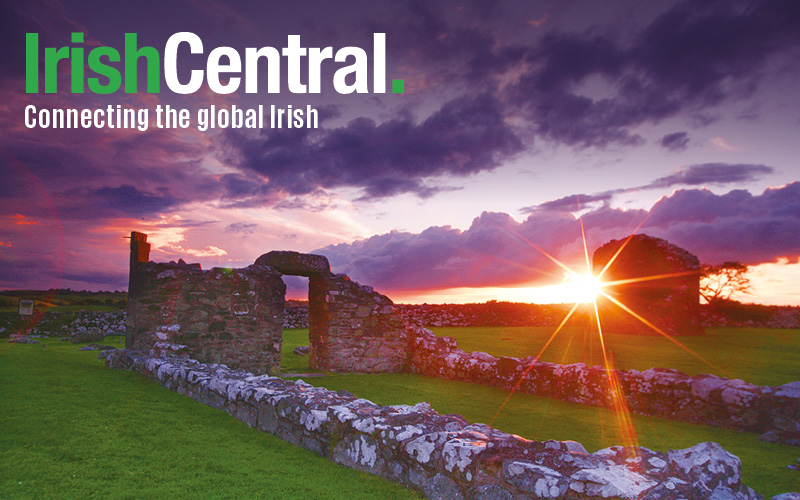| Pic: Caty Bartholomew |
I'm thrilled to bits this minute. The story, which I'm going to relate in my own roundabout way, spans the millennia, heralds the arrival in the Emerald Isle of a mighty new American saint, and it will deliciously warm the cockles of every Irish heart.
Furthermore, it is almost certain to be warming all your other cockles and muscles in the near future. And its consequences have the potential to solve our pressing economic problems in the near future as well.
This is such earth-shattering stuff that St. Patrick's Day might well be renamed St. Alex's Day before the next decade is over. Smile and be happy.
First, you must all come back with me to Connemara as it was over 7,000 years ago. That's a long time ago and everything looked very different back then at the end of the Ice Age.
The rocky reaches of the modern era were then covered with magnificent oak forests which bowed their green heads to every breeze over our ancient ancestors and easily braved the gales with powerfully thewed limbs.
---------------------
Read more:
More articles on Irish history from IrishCentral
John Walker Lindh, the American Taliban, seeks Irish citizenship - POLL
Obama’s Irish cousin wants out of jury duty to meet US president
---------------------
But the forests' real enemy was already winning the battle against them. The peat bogs which cover Connemara so brownly and totally today were rising inexorably up around the trunks.
Most of the trees never fell. They were simply suffocated slowly but surely by the rising bogland around the forests, finally being buried altogether.
I've simplified a long and complex process, but that is what happened. To be just a little bit technical I will add that the low pH and the lack of oxygen in the bogs mummified and preserved the oak and slowly turned it black.
We always knew about it in the centuries since and called it bog oak. We'll leave it there for the moment.
History rolled over us in the centuries that followed. We had our fair share of both joys and sorrows, all well chronicled, our wars and invasions and plagues and famines.
St. Patrick came and changed the insides of our heads, the Vikings came and chopped them off until we chopped theirs off at Clontarf, the Normans came and we subsumed them easily into our genetic mainstream and so on and so forth.
And then the English came and have played puck with our peace and happiness and cultural ease until the day before yesterday, and it’s not over yet either, but let’s leave that alone now and move on with the yarn.
We had a great linen industry a few centuries ago and the English throttled that to protect their own.
Their Scottish aides saw to it that our thriving whiskey industry was also almost throttled to death. Again to protect their own industry.
In the 1950s and 1960s of the last century a whole raft of small Irish distilleries, many in the midlands, were forced out of business. Basically only Irish distillers survived in the Republic.
Poignantly some of the small midlands distilleries continued to keep their doors open just as museums.
One of these was Lockes in Kilbeggan, and it is here in the recent past that the Cooley Distillery run by the Teeling family has been quietly and successfully developing and selling a new generation of super upmarket Irish whiskeys. The Scots are quaking in their breeks.
Now rise with me in salute to St. Alex Chasko. Or genuflect if you so wish because MacConnell's normally impeccable sources say that this largely (here) unknown young American genius is the man leading Ireland to whiskey glory again.
He is a master distiller, I'm told, imported by Cooley to transform their new products and develop new and exciting spirits. And I am reliably informed that the entire Irish trade is all agog about his latest and rapidly developing project.
What has he done?
What he has done is create kegs from some of that 7,000 year old Connemara bog oak and inside those kegs, already, a unique Locke whiskey is rapidly maturing and aging.
In a real sense, given the ritual connection between keg and spirit, this will be 7,000 year old Irish whiskey when it is eventually released and that, surely, will put infant 18 year old Scotch in the shade!
With the prices commanded today by even ordinary single malts, there is no telling what the bog oak whiskey from Kilbeggan will cost if it ages well and is a success. I'm told all the omens are very good.
I bet many of you are smiling now!
There are cockle-warming times ahead, please God, the economy will be rescued effortlessly, and all our futures will be brighter.
I've not met Saint Alex, but my sources showed me a photo of a pleasantly smiling young man, probably in his late thirties, still in his creative prime. The citizens of Kilbeggan should ensure he never has to put his hand in his pocket for anything any time he takes a break from working on a project which could transform the entire island.
Slainte! Slainte! Slainte!




Comments